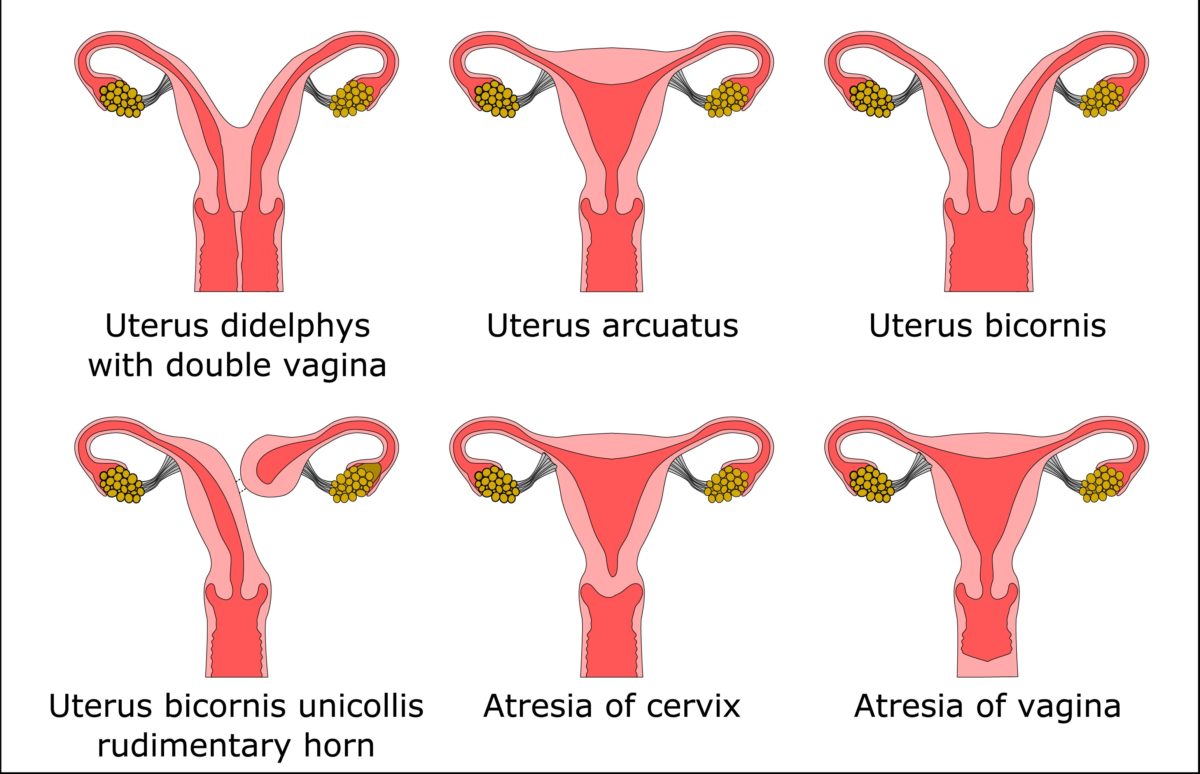Vaginal hysterectomy is a surgical procedure to remove the uterus through the vagina. When the uterus is removed by making an incision over the abdomen, the surgical procedure is called an abdominal hysterectomy. The choice of surgery depends on the size and shape of the uterus and the indication for surgery, which is up to the surgeon. Following hysterectomy, a woman would no longer be able to get pregnant and their periods would stop as well. Hence, if a woman is planning to retain her fertility, it is advised to inform the doctor, so they would be able to suggest other treatment options.
Hysterectomy is usually indicated to treat various gynecological conditions affecting the reproductive organs when other treatment modalities are ineffective. The female reproductive organs include the vagina, cervix, uterus, fallopian tubes, ovaries, other accessory glands, and external genitals. A partial hysterectomy is a type of surgery designed to remove a woman's uterus, leaving her cervix intact. This procedure may be recommended to treat ovarian, uterine or cervical cancer, as well as uterine fibroids, endometriosis, uterine prolapse pelvic pain or abnormal vaginal bleeding.
A patient for whom a partial hysterectomy is appropriate might opt for the removal of her cervix as well as a preventive measure for added peace of mind. However, she should be aware that there are benefits to retaining her cervix, such as a sounder inner pelvic structure and enhanced sexual enjoyment. It may take longer or shorter depending on the extent of disease in the reproductive organs for which hysterectomy is being performed. If either one or both the ovaries and fallopian tubes are also removed along with the uterus, the procedure is called total hysterectomy with salpingo-oophorectomy. The hospital stays and the postoperative recovery period following vaginal hysterectomy are shorter compared to abdominal hysterectomy. A total abdominal hysterectomy, is when both the body of the uterus and and cervix is removed.
A subtotal hysterectomy removes the body of the uterus but not the cervix. In cases of cancer, an extended or radical hysterectomy may be performed. This involves removal of the womb, fallopian tubes and ovaries, and the upper part of the vagina. A vaginal hysterectomy is where the hysterectomy is performed through the vagina instead of through an abdominal incision.
When the uterus is prolapsed it is often removed through the vagina by means of a vaginal hysterectomy, which leaves no abdominal scar. Some surgeons prefer to do a vaginal hysterectomy even in the absence of prolapse. Laparoscopic hysterectomy is known as keyhole surgery and the uterus is removed though four small incisions or cuts on the abdomen. A radical hysterectomy can also be done using laparoscopy or robot-assistance. (See the Simple hysterectomy section for a description of laparoscopy.) These techniques are also referred to as minimally invasive surgery.
Laparoscopic surgery can result in less pain, less blood loss during the operation, and a shorter hospital stay compared to open surgery. Having a radical hysterectomy through an abdominal cut is the preferred type of surgery in most cases. Laparoscopic surgery may still be an option for a small specific group of women with early stage cancer, but you should discuss your options carefully with your doctor. In a vaginal hysterectomy, the uterus is removed through the vagina. With this type of surgery, you will not have an incision on your abdomen.
Because the incision is inside the vagina, the healing time may be shorter than with abdominal surgery. Vaginal hysterectomy causes fewer complications than the other types of hysterectomy and is a very safe way to remove the uterus. It also is associated with a shorter hospital stay and a faster return to normal activities than abdominal hysterectomy. A radical hysterectomy is a procedure used to treat cervical cancer that involves removing the uterus, cervix, tissue around the cervix and the upper part of the vagina. In many patients, the pelvic and abdominal lymph nodes, ovaries and fallopian tubes are also removed during a radical hysterectomy.
Abdominal hysterectomy can be performed even if there are adhesions or if the uterus is very large. It generally requires a longer hospital stay and a longer recovery time than vaginal or laparoscopic hysterectomy. It is the second most commonly performed gynecological surgical procedure, after cesarean section, in the United States.
Nearly 68 percent were performed for benign conditions such as endometriosis, irregular bleeding, and uterine fibroids. It is expected that the frequency of hysterectomies for non-malignant indications will continue to fall given the development of alternative treatment options. A subtotal hysterectomy removes the uterus but leaves the cervix. A radical hysterectomy removes the uterus, cervix, tubes, ovaries and the pelvic lymph nodes.
This is usually done for patients with cancer or other serious diseases. The surgeon then removes the uterus, with or without fallopian tubes and ovaries, through the vagina. If the top of the vagina is sutured through keyhole incisions, the operation is called a total laparoscopic hysterectomy. If the gynaecologist stitches the top of the vagina through the vagina, it is called a laparoscopically assisted vaginal hysterectomy.
In a total vaginal hysterectomy, the uterus is removed through the vagina using an incision concealed at the top of the vagina. The surgeon uses this incision to introduce surgical instruments to detach the uterus and cervix and remove them through the vaginal opening. Fallopian tubes and ovaries may also be removed through the same incision during the surgery, decreasing the risk of ovarian cancer. The incision at the top of the vagina is then closed using dissolvable stitches. A hysterectomy is sometimes performed to treat a prolapsed uterus, endometriosis, uterine fibroids, or other bleeding and pain disorders in the lower reproductive system (1-3). They are also performed to treat or prevent reproductive cancers, such as uterine or cervical cancer .
Hysterectomy, the surgical removal of the uterus or womb, is the second most common surgery performed on women of reproductive age in the United States, second only to C-section. During a hysterectomy, the doctor may remove other organs, such as the fallopian tubes and ovaries. Removing the fallopian tubes at the time of hysterectomy, which is called opportunistic salpingectomy, can help decrease a woman's risk of ovarian cancer. Compared with abdominal hysterectomy, laparoscopic surgery results in less pain, has a lower risk of infection, and requires a shorter hospital stay. You may be able to return to your normal activities sooner.
It can take longer to perform compared with abdominal or vaginal surgery, especially if it is performed with a robot. Also, there is an increased risk of injury to the urinary tract and other organs with this type of surgery. Both vaginal and laparoscopic procedures are considered minimally invasive because they involve smaller incisions. During a vaginal hysterectomy, the uterus is removed through the vagina.
Vaginal hysterectomy generally causes fewer complications that either abdominal or laparoscopic surgery. Elderly and medically compromised patients can benefit from a vaginal approach because it eliminates the risks that can accompany an abdominal incision. Typically, recovery is easier with less invasive methods of hysterectomy compared with abdominal surgery.
For this operation, the surgeon removes the uterus along with the tissues next to the uterus , the cervix, and the upper part (about 1 inch [2-3cm]) of the vagina next to the cervix. The ovaries are not removed unless there is some other medical reason to do so. More tissue is removed in a radical hysterectomy than in a simple one, so the hospital stay can be longer. Some lymph nodes will also be removed and checked for cancer at this time.
A doctor may recommend a hysterectomy to treat uterine fibroids, endometriosis, adenomyosis and other potential causes of pelvic pain or abnormal uterine bleeding. Hysterectomy may also be used to treat uterine prolapse and gynecologic cancers. Uterine artery embolization is a minimally invasive procedure for treatment of uterine fibroids. Under local anesthesia a catheter is introduced into the femoral artery at the groin and advanced under radiographic control into the uterine artery. A mass of microspheres or polyvinyl alcohol material is injected into the uterine arteries in order to block the flow of blood through those vessels. The restriction in blood supply usually results in significant reduction of fibroids and improvement of heavy bleeding tendency.
The 2012 Cochrane review comparing hysterectomy and UAE did not find any major advantage for either procedure. While UAE is associated with shorter hospital stay and a more rapid return to normal daily activities, it was also associated with a higher risk for minor complications later on. There were no differences between UAE and hysterectomy with regards to major complications. During a total hysterectomy, the uterus and cervix are removed. During a subtotal hysterectomy, only the uterus is removed.
In either case, the ovaries remain and the fallopian tubes are usually removed to reduce the risk of future cancer related to the fallopian tubes. If you have not yet reached menopause, the ovaries will keep making hormones. For pre-cancerous cells, there are a few options that you and your health care provider should discuss. Loop Electrosurgical Excisional Procedure can be used to remove pre-cancerous cells, and cryosurgery can be used to treat non-cancerous growths and abnormal tissue. For early invasive cervical cancer that has not spread to other regions, a radical trachelectomy can be performed in lieu of a total hysterectomy. Vaginal Hysterectomy describes a surgical procedure in which the uterus is removed through the vagina.
One or both ovaries and fallopian tubes may be removed during the procedure, as well. Risks associated with the vaginal approach include a slight but serious risk of shortening or damaging the vagina. Vaginal hysterectomy has also been shown to be the most cost effective form of procedure.
Recovery from a vaginal or laparoscopic hysterectomy takes much less time than from an abdominal surgery. After a routine laparoscopic surgery removing the uterus but not the cervix , most women are able to return to normal activity in 1 to 2 weeks. About 4 to 6 weeks after the hysterectomy, see your doctor for a follow-up examination. In a radical hysterectomy, the uterus and some surrounding parts around the cervix are removed.
The open radical hysterectomy is performed by removing the uterus through an incision (similar to the one made in a C-section) in the lower abdomen. Radical hysterectomies typically are used in cancer treatment to ensure that all of the cancer is removed. If you have cervical cancer, uterine cancer, or severe uterine hemorrhage, hysterectomy may be the best choice for your health.
According to the National Center for Health Statistics, of the 617,000 hysterectomies performed in 2004, 73% also involved the surgical removal of the ovaries. In the United States, 1 in 3 women can be expected to have a hysterectomy by age 60. There are currently an estimated 22 million women in the United States who have undergone this procedure. Nearly 68 percent were performed for benign conditions such as endometriosis, irregular bleeding and uterine fibroids.
Such rates being highest in the industrialized world has led to the controversy that hysterectomies are being largely performed for unwarranted reasons. More recent data suggests that the number of hysterectomies performed has declined in every state in the United States. Now hysterectomy is one of many options if you have fibroids ,excessively heavy periods, or uterine prolapse . Radical hysterectomy does not change a woman's ability to feel sexual pleasure.
Although the vagina is shortened, the area around the clitoris and the lining of the vagina is as sensitive as before. A woman does not need a uterus or cervix to reach orgasm. When cancer has caused pain or bleeding with intercourse, the hysterectomy may actually improve a woman's sex life by stopping these symptoms. More information about managing the sexual side effects of cervical cancer treatment can be found in Sex and the Woman with Cancer. A radical hysterectomy may be performed to treat cervical or uterine cancer. A laparoscopic hysterectomy requires only a few small incisions, compared to a traditional abdominal hysterectomy which is done through a 3-6 inch incision.
As a result, there is less blood loss, less scarring and less post-operative pain. A laparoscopic hysterectomy is usually done as an outpatient procedure whereas an abdominal hysterectomy usually requires a 2-3 day hospital stay. The recovery period for this laparoscopic procedure is 1-2 weeks, compared to 4-6 weeks after an abdominal hysterectomy.
A hysterectomy is surgery to completely or partially remove the womb . This is done to relieve symptoms caused by medical conditions affecting the womb. It is a major surgical procedure that is associated with risks and side effects. So it is usually only considered if other treatments aren't effective enough. If a woman has uterine or ovarian cancer, though, a hysterectomy may be necessary in order to remove the tumor.
Radical hysterectomy is the most extensive of hysterectomy procedures and is typically performed to treat gynecologic cancers, such as cervical cancer or endometrial cancer . A radical hysterectomy removes all of the uterus, the cervix, the upper portion of the vagina and surrounding tissue. It also allows better exploration and slightly more complicated surgeries than the vaginal procedure. LAVH begins with laparoscopy and is completed such that the final removal of the uterus is via the vaginal canal. Thus, LAVH is also a total hysterectomy; the cervix is removed with the uterus. If the cervix is removed along with the uterus, the upper portion of the vagina is sutured together and called the vaginal cuff.
There are several approaches to hysterectomy or surgical removal of the uterus. Each option involves unique risks and benefits, and recovery time can vary depending on the method used. In some instances, a woman's choice of procedure is limited — for example if she has a very large uterus, a vaginal or laparoscopic procedure may not be an option. Depending on the condition you are facing, you may be able to keep your uterus intact.
Alternatives are out there for about 90 percent of hysterectomies surgeons do, according to Streicher in her book The Essential Guide to Hysterectomy. Fibroids, for example, may be treated using a nonsurgical procedure called uterine artery embolization that cuts off the fibroids' blood supply. Another option is myomectomy, which removes fibroids but spares the uterus. For heavy bleeding, an ablation procedure — which freezes or burns the uterine lining — may be a treatment option. Before scheduling a hysterectomy, have a discussion with your doctor about the alternative treatments for your condition. If you have cancer of the uterus, cervix, endometrium or ovaries, or precancerous changes, your doctor might recommend a hysterectomy.
Most often, treatment for ovarian cancer involves an abdominal hysterectomy, but sometimes vaginal hysterectomy is appropriate for women with cervical or endometrial cancer. Our surgeonsare committed to providing the best treatment option for every individual patient. Always ask your doctor about all treatment options, as well as their risks and benefits. A hysterectomy is a surgical operation to take out a woman's uterus. Doctors perform the surgery to treat several health problems, including uterine fibroids, cancer and prolapse. Hysterectomies are major surgeries with several risks, but most women do not experience complications.





























No comments:
Post a Comment
Note: Only a member of this blog may post a comment.